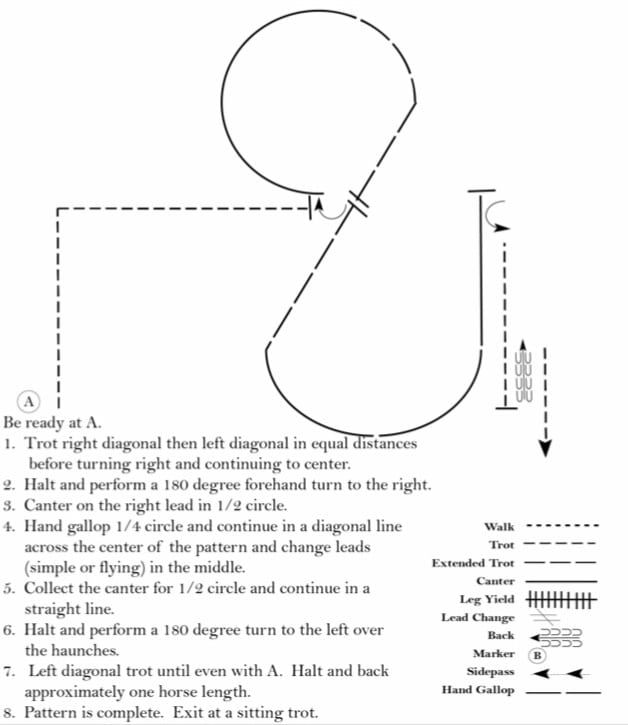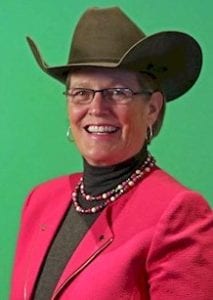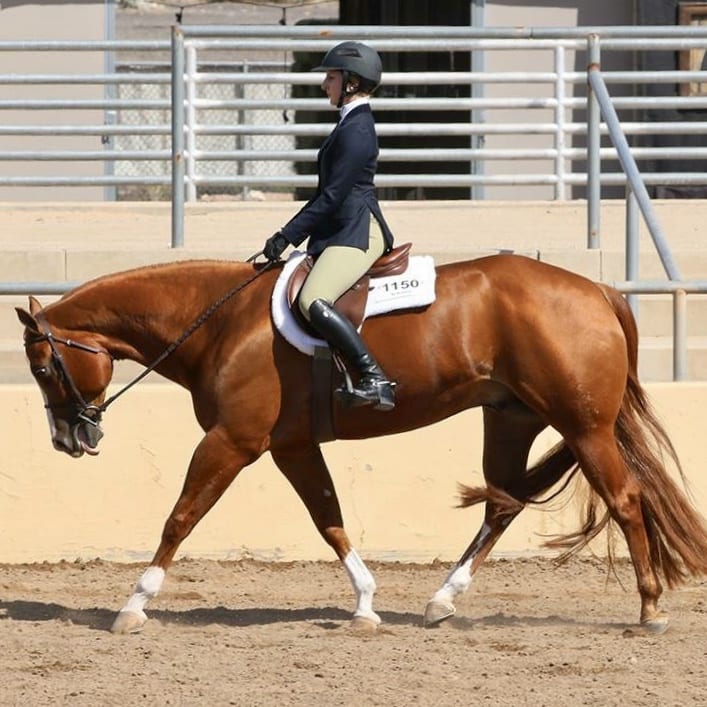GoHorseShow would like to thank Judge Holly Hover from Cave Creek, Arizona for taking the time to break down the Congress Youth 12-14, 15-18 and Amateur Hunt Seat Equitation pattern for us. A huge bonus is that Hover is a judge at this year’s show.
Holly trains all-around horses in Cave Creek, AZ. She also holds judges cards with AQHA, NSBA, NRHA and APHA. Her program has produced multiple AQHA World Champions as well as NSBA, APHA and Quarter Horse Congress winners. In 2017, she was named AQHA Professional Horsewoman of the Year. This is Holly’s seventh time to officiate at the All American Quarter Horse Congress.
We would also like to thank HorseShowPatterns.com for allowing us to post the pattern in the article. You may view the pattern that is displayed below or download it here. GoHorseShow chose this pattern because we thought it would be beneficial to break down one of the more challenging classes and some of the less complicated patterns have many of the same maneuvers.
Hunt Seat Equitation Pattern Breakdown as seen by Holly Hover
What a great pattern for this year’s Congress 12-14, 15-18 and Amateur Hunt Seat Equitation. I think it will be a challenging test, one that will require a definite plan for pattern placement as well a pattern that will allow the exhibitor a chance to showcase control, connection and thought process.
- Be ready at marker A, (marker on your left leg) don’t underestimate the importance of the judge’s first impression. You should be standing squarely with your horse in frame. You should be in correct position with eyes on the judges, ready to begin your pattern as soon as the flag drops.
 The pattern begins – 1) Trot right diagonal then left diagonal in equal distances before turning right and continuing to center. In a perfect execution, you would move forward into your right diagonal smoothly and timely from the start – eyes up, the horse in frame, with a clear plan of where your diagonal change will occur. The graphic shows a square corner as you continue to center, however the instructions do not specify this. I would think a tight corner would be sufficient. Remember that ‘center of the arena’ has two vantage points from the top and bottom of the arena as well as the side walls.
The pattern begins – 1) Trot right diagonal then left diagonal in equal distances before turning right and continuing to center. In a perfect execution, you would move forward into your right diagonal smoothly and timely from the start – eyes up, the horse in frame, with a clear plan of where your diagonal change will occur. The graphic shows a square corner as you continue to center, however the instructions do not specify this. I would think a tight corner would be sufficient. Remember that ‘center of the arena’ has two vantage points from the top and bottom of the arena as well as the side walls.- Halt and perform a 180-degree forehand turn to the right. I would appreciate a soft, balanced stop with constant connection with your horse. Moving into the forehand turn, your horse should yield willingly from your leg. I don’t think ‘mock speed’ is what you are shooting for here. Strive to find a pace that best suits your horse’s conformation and ability throughout the turn.
- Maneuvers 3, 4 and 5 are an interesting combination. To begin with, canter on the right lead for 1/2 a circle. Here’s where your decision of the size of the circle starts. Keeping in mind marker A, I would think it would best to execute a circle that will ensure that you balance the top half of your pattern with the lower half. We shouldn’t see a top heavy or bottom heavy pattern placement.
- As you move into the hand gallop for a 1/4 circle and then continue into a diagonal line across the center of the pattern to the lead change, it is essential that you move forward with pace as well as into the two-point position. The transition into the two-point should be one motion of moving into the lifted seat as well as taking a shorter rein and maintaining a good feel or connection with your horse.
- The lead change may be either executed as a flying or simple change and should be departed in the same forward pace of the hand gallop. Continue to a spot just before marker A and then return to the collected canter before rounding into your half circle and finding that straight line back to a point just past center. I think your eyes will be a definite asset throughout all of the canter maneuvers, helping you find those arcs and both the diagonal and straight lines.
- Maneuver 6…halt and perform a 180-degree turn over the haunches, again should be shown to the best of your horse’s ability. I think soft, correct with lots of flow through balance and connection is a good choice. This is not the reining, so don’t ride it like it is.
- Upon completion of your turn, maneuver 7 calls for a left diagonal trot until even with marker A. Halt and back approximately one horse length. Although it says pattern is complete, it finishes by calling for an exit at the sitting trot. To be safe, I would never feel my pattern is complete until I have exited the arena. Keep showing. Ride smart and good luck!
 About the Author: Holly Hover trains all around horses in Cave Creek, Az. She holds judges cards with AQHA, NSBA, NRHA, and APHA. Her program has produced multiple AQHA World Champions and Reserves as well as NSBA, APHA, and Quarter Horse Congress winners. She was named the 2017 AQHA Professional Horsewoman of the Year. This is Holly’s seventh time to officiate at the All American Quarter Horse Congress.
About the Author: Holly Hover trains all around horses in Cave Creek, Az. She holds judges cards with AQHA, NSBA, NRHA, and APHA. Her program has produced multiple AQHA World Champions and Reserves as well as NSBA, APHA, and Quarter Horse Congress winners. She was named the 2017 AQHA Professional Horsewoman of the Year. This is Holly’s seventh time to officiate at the All American Quarter Horse Congress.







